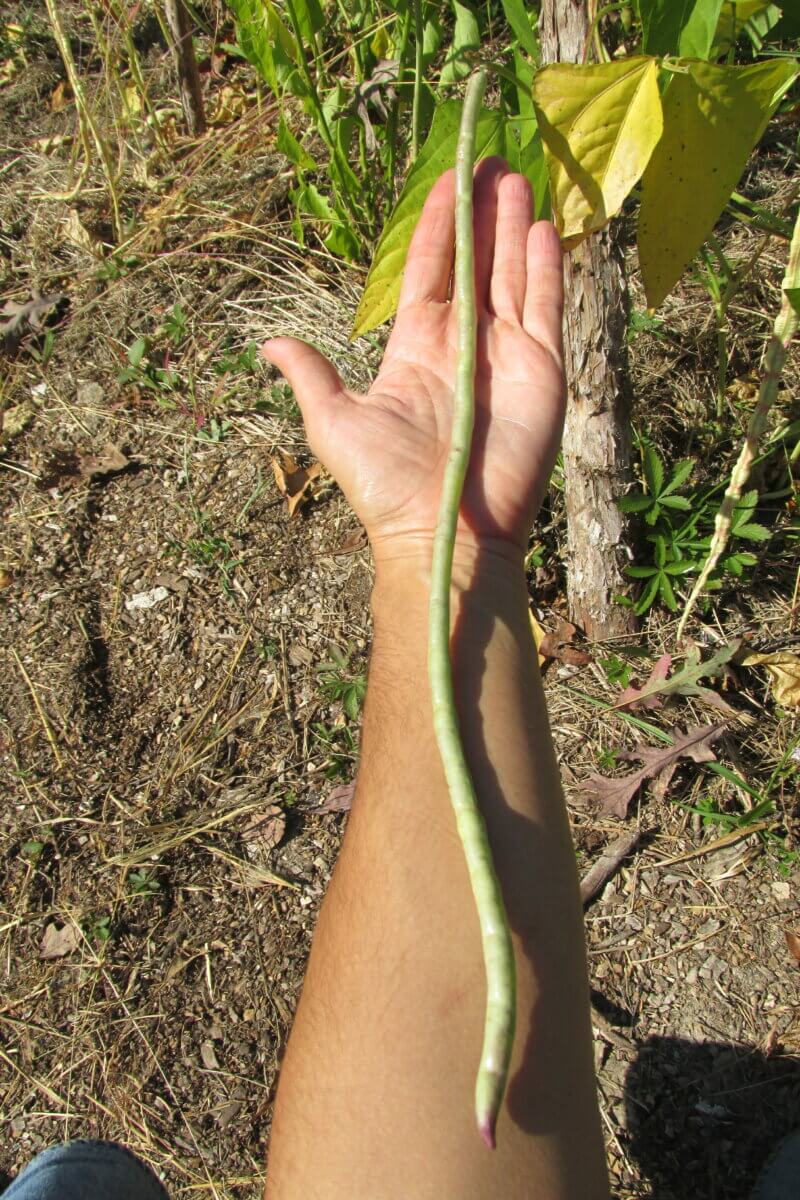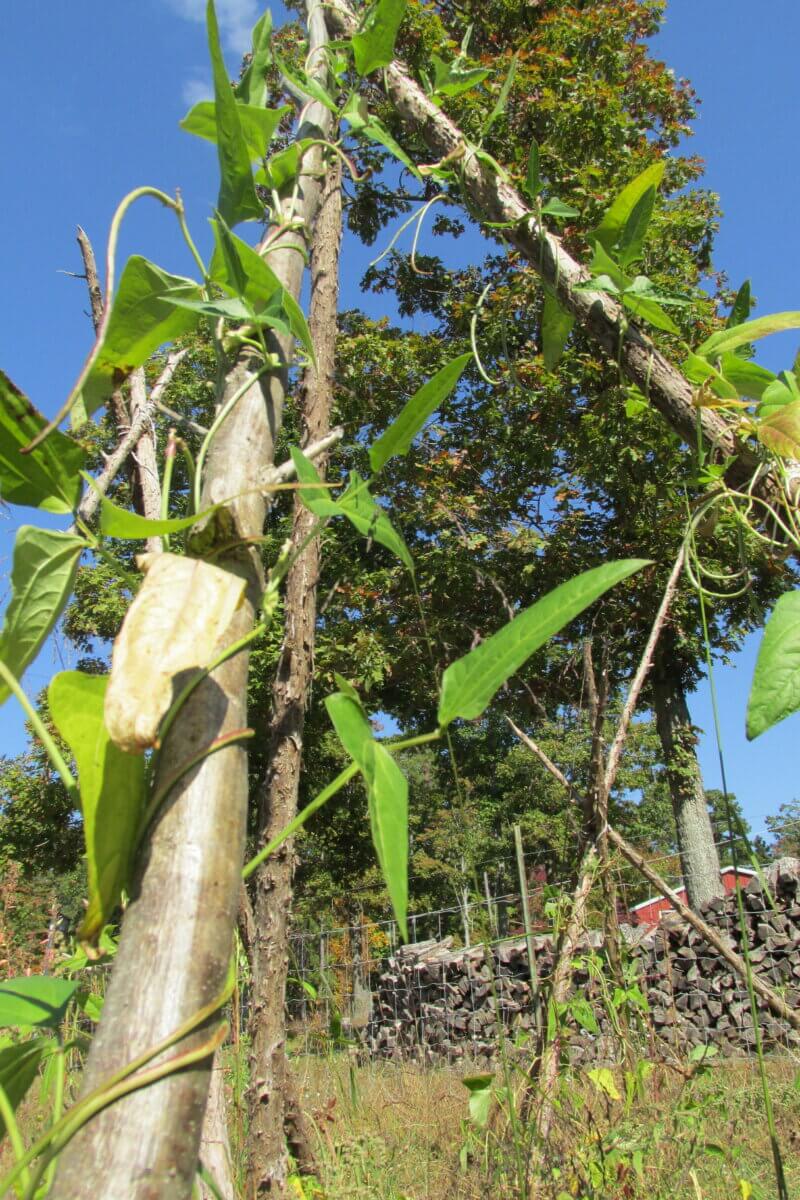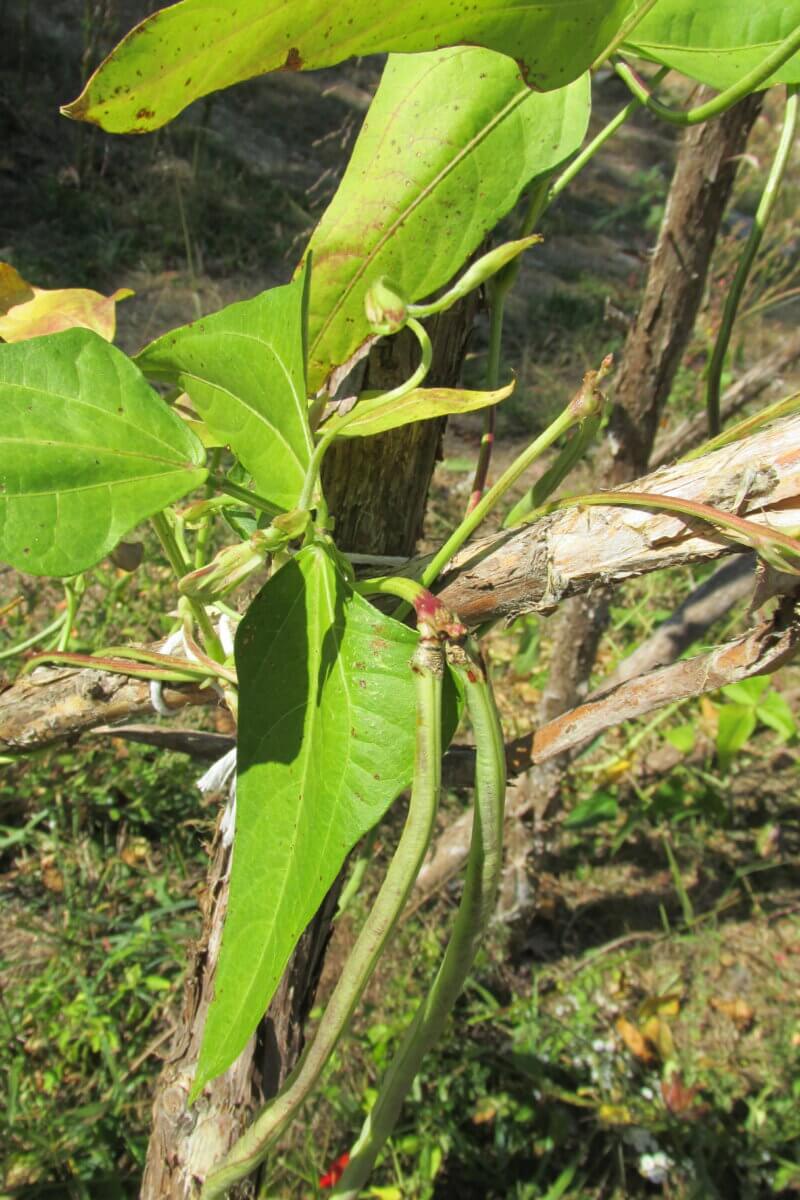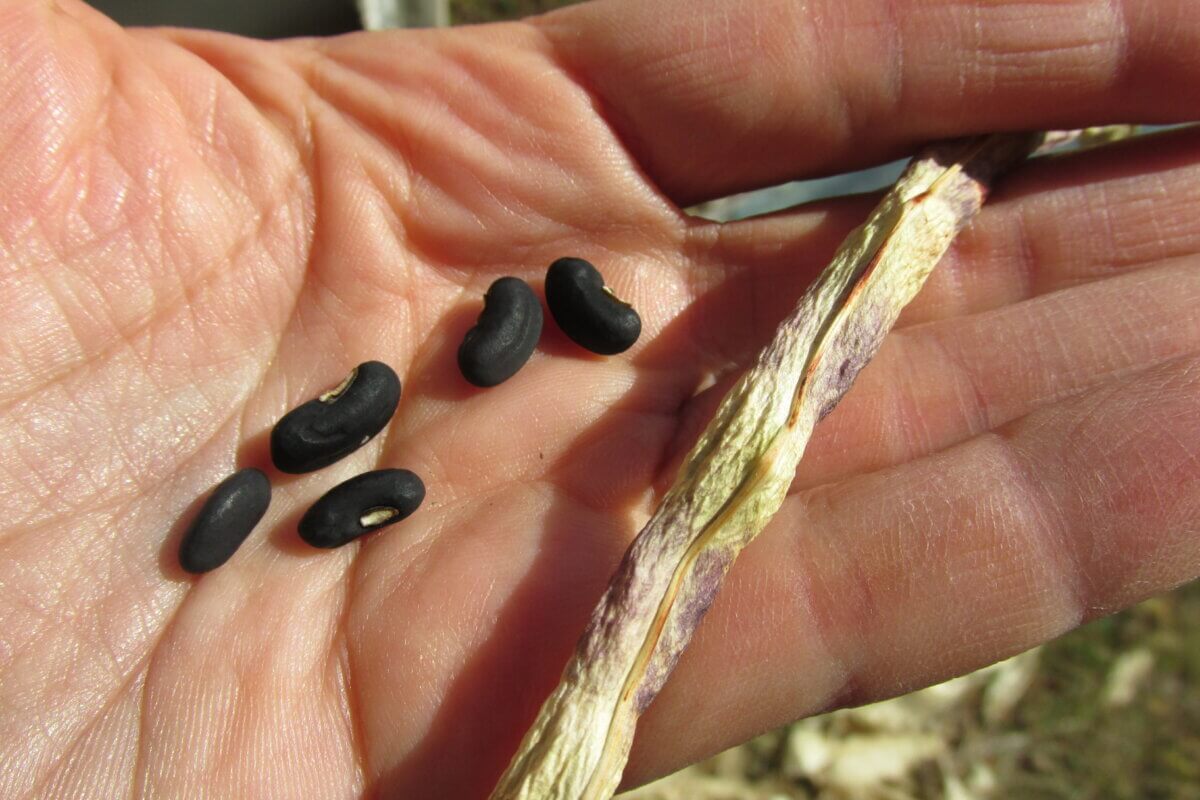The first year we lived on the homestead, before we planted all of our gardens, we got most of our fresh food at the farmers market. One sunny late summer morning, I saw a bunch of shiny, purple-green beans that were so long I couldn’t believe it at a vendor’s stand.
Generous handfuls of beans were tied in neat bundles like a mass of dreadlocks, and I was excited. When we still lived in the city, the last time I had them was after going grocery shopping in Chinatown.
The soft-eyed woman looked at me with a bit of a shrug. “You’re the only one who’s been interested. I’ve not made a single sale of these beans. Folks can’t get over the purple color — even though they turn green when you cook ’em. ”.
We left the market with the whole lot and feasted on garlicky stir-fried beans for lunch.
Now that our gardens are well established, I don’t think I’d ever skip planting a few rows of these strangely long, highly productive beans.
They’ve been known by many names, such as noodle beans, snake beans, dow guak, asparagus beans, yardlong beans, Chinese long beans, and Vigna unquiculata var. sesquipedalis, I’d hazard a guess that many of you have never heard of these legumes (by any name). But if I do my job right, I hope you will grow this lovely, unique, and tasty plant with me next season.
Also known as yard-long beans, bora, snake beans and Chinese long beans, long beans have long been a staple ingredient in Asian cuisines. With their crisp, delicate flavor and chewy texture, it’s no wonder cooks worldwide have embraced these versatile legumes. But for the uninitiated, questions remain about how to select, prep and cook long beans. Here, we’ll explore everything you need to know about integrating long beans into your kitchen repertoire.
Long beans are a variety of cowpea native to tropical regions of Africa and Asia. The beans can grow over 3 feet long, but are typically harvested at 18-24 inches. They have a crunchy, dense texture akin to asparagus, with a taste similar to snap peas. When raw, long beans are slightly sweet and grassy. Cooked, they become more robust, nutty and earthy. The skins stay tender even when mature.
Compared to green beans, long beans have a meatier bite. They also pack more protein and fiber. Best of all, these vitamins and minerals come with just 50 calories per cup.
So what exactly do cooks do with long beans? Let’s explore some of the most popular uses:
Using Long Beans in Stir-Fries
The most traditional use for long beans is Asian stir-fries. The vegetable’s crunchy texture pairs perfectly with seared meats and bold sauces. To stir-fry, cut long beans into 1-2 inch diagonal slices. Cook over high heat with soy sauce, oyster sauce, hoisin, garlic, ginger and spices. Add bites of chicken, pork, beef or shrimp. Long beans shine in noodle and fried rice dishes too. Their sturdy texture won’t overcook.
Braising and Stewing Long Beans
The dense texture of long beans also lends itself well to braises and stews. Simply add chopped long beans to curries, chili, soups and more. Braise chunks of long beans with coconut milk and Thai spices for a flavorful side. The beans hold their shape beautifully without turning mushy. Slow cooking intensifies the earthy, nutty taste. Just avoid overcooking, which can make beans slimy.
Blanching Long Beans
Many chefs recommend quickly blanching or steaming long beans before stir-frying or sautéing. This pre-cooking helps remove any bitterness while retaining the signature crunch. To blanch, boil beans for 1 minute, then shock in ice water. Pat dry before sautéing or adding to dishes. Blanching also amplifies the vibrant green color.
Preparing a Long Bean Salad
The crisp texture of raw long beans makes an excellent addition to cold salads. Simply slice beans into 1-inch pieces and toss with ingredients like cucumbers, bell peppers, cabbage, leafy greens, fresh herbs, nuts and a light dressing. Long beans add beneficial fiber and plant-based protein. For salads, select young, slender beans. Avoid any bulging seeds.
Serving Long Beans as a Side
You can also highlight the flavor of long beans by simply steaming or sautéing them as a side Quick-cook until just tender but still crunchy, about 5 minutes. Toss with salt, pepper, garlic, lemon juice or herbs Sauteed long beans pair perfectly with fish, chicken, pork and beef entrées. They make an easy substitute for green beans. Just note that long beans rarely turn soft, even with extended cooking. Expect a pleasant chew.
Pickling Long Beans
The firm texture of long beans also makes them a candidate for pickling. Use young slender beans. Pack into sterilized jars with a brine of vinegar water, salt, sugar and spices. Refrigerator pickles take just a few hours, while processed jarred pickles require canning. Spicy pickled long beans can accentuate cheese boards, burgers, tacos and more.
Top Tips for Cooking with Long Beans
Follow these tips for obtaining the best results when cooking with long beans:
-
Look for slender, unbulging beans under 24 inches long. Avoid any yellowing.
-
Store unwashed beans in a plastic bag for 2-3 days. Wash right before use.
-
Trim stem ends before cooking. Slice diagonally into 1-2 inch pieces.
-
Stir-fry over high heat for 2 minutes until crisp-tender. Avoid overcooking.
-
Braise or stew for 15-20 minutes until beans are tender but still have bite.
-
Blanch beans for 1 minute before sautéing to amplify color and flavor.
-
For salad, use young raw beans sliced thinly. Massage oil and acid in.
-
Pick young beans and refrigerate brined pickles for 1 week before eating.
With their subtly sweet flavor and satisfying crunch, it’s easy to see why long beans shine in cuisines across the globe. They require minimal prep and add beneficial nutrition. Next time you spot these skinny legumes at an Asian grocer, consider picking some up. Long beans will soon become your new go-to vegetable for stir-fries, cold salads, braises and more!
References
-
Jong, E. (2020). Meet Long Beans, the Asian Legume You Should Be Eating More Of. Epicurious.
-
McDermott, N. (2020). How to Prep and Cook Long Beans, the Unsung Legume You Should Be Eating. Bon Appetit.
-
Russo, J. (2019). What Exactly Are Long Beans? Kitchn.

What Are Long Beans?
The eponymous seed pods come in a variety of colors including green, purple, and even a shiny red. I know the name of these beans may seem an exaggeration, but it’s not a misleading one. The thin, edible pods of this vining bean are longer than any you’ve ever seen.
Though they really can reach an incredible 3 feet long in ideal conditions, they more usually grow to 1 or 2 feet — which is the variation part of the scientific name. Sesquipedalis means “foot-and-a-half” and is a pretty accurate measurement for most pods.

These beans flourish in the heat and are actually more closely related to cowpeas than the common green beans you typically grow. And like cowpeas, they need a nice, long growing season — around 75 days. Though there are a few cultivars (such as orient wonder) specifically aimed at colder regions, gardeners in zones 5 and up will have the best success growing these beans.
Related Post: Growing Green Beans
These are short-day plants, meaning that they won’t start flowering or forming those gorgeous pods until mid or late summer. Once they do start to flower, though, you may be surprised by the delicate beauty of their purple, pea-like blossoms. As an edible landscaping feature, they are definitely a conversation piece!
Yardlong bean vines get big—about 8 feet long when they’re fully grown—but their leaves aren’t too much, and they can grow in any direction. Even though they’re big, they can easily fit in a small garden as long as you set up a nice trellis for their vines and put them in the back where they won’t shade anything else.
Although they grow tendrils that look like peas, they prefer to slowly twist around a support as they go. Make sure that your support has a pole or thick string that they can grab and twist around. I have had great success lashing sapling trunks into a simple tripod. Any sturdy branch could do.
Direct sow these beans if you can, as they are not happy about being transplanted. If you live in a place with a short growing season, you can start them in bigger, separate containers about three weeks before the last expected frost.

Don’t set out these heat-loving beans until the nights have reached temperatures in the 60s. About an inch of soil should be used to plant the seeds, and plants should be 4 inches apart. I like to put four seeds close together around the trellis’s support posts and let them grow up in a beautiful, wavy, and a little messy symphony.
You can grow yardlong beans in full sun or light shade. They do best in soil that has some compost mixed in, but they can also grow well in poor soil. They are legumes, so they can fix nitrogen just like the other helpful bean family members.
Related Post: Growing Black Beans
And like their cowpea cousins, yardlong beans are champs when it comes to drought. You should water your garden plants regularly, but a dry spell won’t kill your beans like it might other plants in your veggie patch.
These plants are also very easy to grow because pests and diseases don’t bother them much, if at all. The only trouble you may face is an occasional summer with inexplicably low yields. I’ve not had that summer yet, but I hear they can happen.
Harvesting long beans is as easy as growing them. Just pick them off the vine when they’re at least a foot long, and make sure you check on your bean patch every day. There will be more waiting for you. Though they grow to a great length, long beans stay tender for a really long time.

Once they lose their green shine and turn pale yellow, they’re already dead. If they get that far, leave the pods alone to make seeds for next year.
Just be sure to leave the growing buds alone when you’re harvesting your beans. The buds will continue to grow pods on the same stem if undamaged.
Saving seeds from your vines is a snap. They’re self-pollinating and unlikely to cross, so heirloom varieties will have no problem breeding true. Select some of the best-looking pods from your best-growing plants, and simply leave them alone. They’ll grow and grow and grow, shifting from their glossy green or purple to a waxy yellow. Then they’ll start to dry.

When the seedpod is almost dry, but not quite, pick it up and let it dry all the way through until it’s crispy. If you don’t, it might break and scatter the seeds. They are easy to break: just squeeze the seedpods together quickly, and the shiny black or maroon seeds will fall out. Store them in a dry, cool location until it’s time to plant again.
The Ultimate Yard Long Bean Growing Guide – From Seed To Harvest #beans #garden #vegetablegarden
FAQ
What is the difference between beans and long beans?
What are the uses of long beans in medicine?
What goes well with long beans?
How to eat yard-long beans?
What are long beans used for?
In Asia, long beans are commonly used in stir-fries with garlic or ginger and can be steamed or boiled before use. In India, they are part of some traditional dishes such as thoran (a coconut-based dish). Additionally, long beans are often fried with spices for an extra layer of flavor.
What are the benefits of eating beans?
Beans are an excellent source of fiber and nutrients such as protein, healthy fats, vitamins and minerals. The benefits of eating beans include body nutrition, weight maintenance, bowel proper function, cholesterol regulation, blood sugar level regulation and more.
Are long beans good for You?
They are a good source of iron, magnesium, potassium, thiamin, riboflavin, niacin, and vitamins A, C, E, and K. These vitamins and minerals support a stronger immune system and healthy skin. Additionally, long beans are a wonderful source of dietary fiber, which supports digestive health and prolongs feelings of fullness.
Why are long beans called long beans?
The name “long bean” comes from their elongated shape, which can grow up to three feet long. They include vitamins A, C, K, and B6, among other necessary vitamins and minerals. Additionally a rich source of protein and nutritional fiber are long beans. Here is all the information you require about long beans. What are Long Beans?
